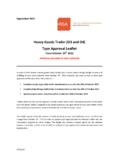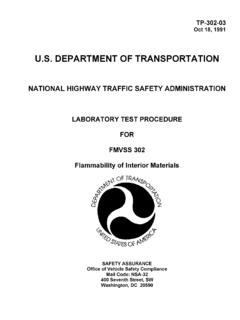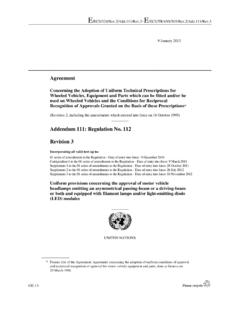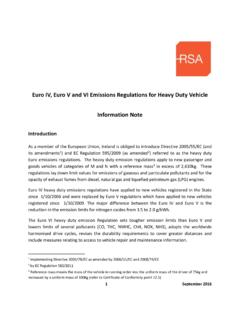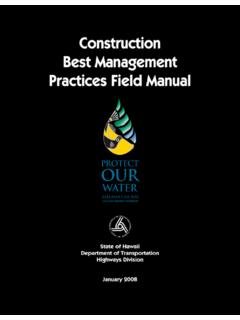Transcription of BY ORDER OF THE AIR FORCE INSTRUCTION 32 …
1 BY ORDER OF THE SECRETARY OF THE AIR FORCE AIR FORCE INSTRUCTION 32-1024 14 JULY 2011 Incorporating Change 2, 3 December 2015 Civil Engineering STANDARD FACILITY requirements COMPLIANCE WITH THIS PUBLICATION IS MANDATORY ACCESSIBILITY: Publications and forms are available on the e-publishing website at for downloading and ordering. RELEASABILITY: There are no releasability restrictions on this publication. OPR: AFCEE/TDB Supersedes: AFI32-1024, 31 May 1994 Certified by: AF/A7CP (Lt Col John J. Allen, Jr.) Pages: 8 This INSTRUCTION implements AFPD 32-10, Installations and Facilities, and Department of Defense INSTRUCTION (DoDI) , Department of Defense Facility Classes and Construction Categories. This INSTRUCTION is applicable to all Air FORCE active duty, civilian, Reserve (AFR) and Air National Guard (ANG) personnel and unit facilities.
2 Air National Guard facility requirements are defined in ANGH 32-1084, ANG Standard Facility requirements . Civil Air Patrol may adopt this guidance at the discretion of the applicable installation commander, per AFI 10-2701. It provides general guidance for developing standard facility requirements . It describes the facility requirements system, assigns responsibilities, and explains how to initiate and process new and revised standards for publication in AFMAN 32-1084, Facility requirements . Civil engineers should use the facility space allowances listed by category code in AFMAN 32-1084 to assign occupancy and to program new facilities. Refer recommended changes and questions about this publication to the Office of Primary Responsibility (OPR) using the AF Form 847, Recommendation for Change of Publication; route AF Forms 847 from the field through appropriate functional chain of command.
3 Ensure that all records created as a result of processes prescribed in this publication are maintained in accordance with AFMAN 33-363, Management of Records, and disposed of in accordance with the Air FORCE Records Disposition Schedule (RDS) located at The use of the name or mark of any specific manufacturer, commercial product, commodity, or service in this publication does not imply endorsement by the Air FORCE . Certified Current 31 March 20162 AFI32-1024 14 JULY 2011 SUMMARY OF CHANGES This Interim Change 2 revises AFI 32-1024 with change 1, 19 December 2014 to incorporate the Compliance Statements recommended for edit, rewrite, and reduction. This was due to the AF publication Assessment for Reform. All the changes accepted has been incorporated in this change 2.
4 1. Facility requirements System: The Facility requirements System develops and approves standards that define the type, number, and size of facilities. The system promotes economy and efficiency in using and developing facilities and helps realize the following goals: Design standards for new and revised functional requirements . Maximum use of existing facilities. Standards of use to justify new facilities and occupy existing facilities. Comprehensive programming for the construction, operation, and maintenance of needed facilities. The organization of the Facility requirements System is based on the DoD Real Property Classification System (RPCS). RPCS is a hierarchical scheme of real property types and functions that forms the framework for identifying, categorizing, and analyzing DoD s inventory of land and facilities.
5 The scheme is a tiered structure represented bynumerical codes, with one-digit codes being the most general and five- or six-digit codes representing the most specific types of facilities. Each Military Service has established its own set of numerical codes, commonly known as facility Category Codes, to represent each type of facility in its inventory. The Air FORCE uses a six-digit hierarchy. Category Codes (CATCODE) are generally similar but not identical between Military Services. However, DoD established a higher-level facility classification that groups facilities with similar functions and units of measure from the Military Services into common Facility Analysis Categories (FAC) at the four-digit level.
6 These FACs allow consistent macro-level analysis and planning across DoD. Successively smaller groupings of facility types are represented by three-, two-, and one-digit numerical classifications. The RPCS structure is numerically consistent between the one-digit and four-digit levels, but it is not always consistent across the Military Services at the five- and six-digit level. Further information on the DoD Real Property Classification System can be viewed on the Office of the Deputy Under Secretary of Defense, Installations and Environment Web site: The Facility requirements System is further defined in AFMAN 32-1084, Facility requirements , which provides guidance and standards for the type, number, and size of facilities the Air FORCE can use, occupy, or build to support its mission.
7 Air National Guard facility requirements are defined in ANGH 32-1084, ANG Standard Facility requirements . A listing in the handbook does not provide automatic justification for programming a facility AFI32-1024 14 JULY 2011 3 or for including it in the base comprehensive plan. All available space is considered when establishing a space deficiency and when justifying programming action. Approved standards published in AFMAN 32-1084 contribute to: Timely acquisition of facilities. Expedited construction program reviews and approvals. Expedited project design. Equitable space allocation in existing facilities; the published standards help divide limited assets among competing functions. Standardization of facility design; the Air FORCE realizes benefits not only in design and construction but also in program management and functional operations.
8 2. Responsibilities: The Deputy Assistant Secretary of the Air FORCE for Environment, Safety and Infrastructure (SAF/IEE) establishes Air FORCE facility requirements policy consistent with DoD policy and standards for facility requirements . The Director of Civil Engineer (AF/A4C): Implements policies and establishes procedures for the Facility requirements System. Monitors Air FORCE -wide programs leading to new or revised facility standards to ensure all functional requirements are satisfied. Consults on architectural, engineering, and other design aspects of proposed facility requirements . Approves standard facility requirements . Prepares AFMAN 32-1084 and ensures it is current. AFMAN32-1084, Table , lists the facility OPRs for each Facility Category Code; these OPRs are the primary action offices for developing facility requirements .
9 Facility OPRs ensure facility requirements supporting new and changing functions are identified early and timely action is taken to develop new standards for approval and publishing. Major commands (MAJCOM), field operating agencies (FOA), and the Air National Guard establish active programs to: Keep abreast of new missions, programs, or concepts that may generate new facility requirements and initiate basing action, as appropriate, for new or modified missions in accordance with AFI 10-503, Base Unit Beddown Program. Develop or refine functional standards for the type, number, and size of facilities needed for mission support. Investigate current facility operations to determine if existing standards are adequate.
10 Obtain approval of new or revised standard facility requirements for publication in AFMAN 32-1084 using the procedure outlined in paragraph 4 of this INSTRUCTION . 4 AFI32-1024 14 JULY 2011 Initiate the Environmental Impact Analysis Process (EIAP) in accordance with 32 CFR 989 The Air FORCE s EIAP (32 CFR 989) [[shall]] be accomplished consistent with the National Environmental Policy Act (NEPA) (Pub. L. 91-190, 42 4321-4347) and the Presidents Council on Environmental Quality (CEQ) Regulations for Implementing the Procedural Provisions of NEPA (40 CFR 1500-1508) prior to implementing any irrevocable actions and/or committing irretrievable resources. (T-1) The proponent of the action (32 CFR (d)) is the person or organization that is responsible for initiating action and is responsible for complying with the EIAP and ensuring integration of the EIAP during the initial planning stages of proposed actions so that planning and decisions reflect environmental values, delays are avoided later in the process, and potential conflicts are precluded.










